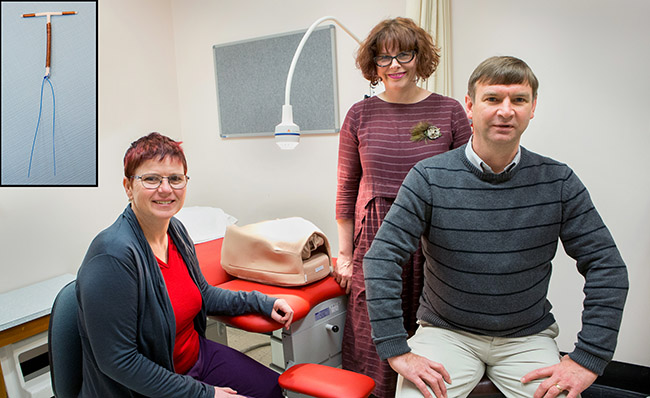
The team (from left) Helen Paterson, Emma Macfarlane and Michael Stitely. Photo: Sharron Bennett.
A device that could help decrease the global burden of unwanted pregnancy has been invented by University of Otago academics.
The invention will make it safer and easier for birth attendants, such as midwives, to insert an intra uterine contraceptive device (IUD) immediately after a woman gives birth.
One of the inventors, Associate Professor Michael Stitely, of the Department of Women's and Children's Health, says IUDs are small, T-shaped devices offering up to 10 years of contraception which are inserted in the uterus through the cervix.
The best time to insert them is straight after birth, however, the current method requires surgical skills, dramatically limiting their use.
“We attended an IUD training session for registrars and saw how difficult they found inserting them in a simulation model,” he says.
“We thought: There has to be a better way.”
Associate Professor Stitely sketched an idea for a device that would assist with the insertion on a scrap of paper. Then he and his team drew it up using a computer assisted drawing (CAD) programme, and created a prototype using a desktop 3D printer.
“It was great to be able to hold it in our hands and make changes to dimensions and shapes until we got it right.”
The device has the potential to save tens of thousands of lives, as the World Health Organisation estimates up to 100,000 maternal deaths per year could be avoided if effective contraception was used by those who didn't want children.
The invention is now one step closer to medical reality after winning Otago Innovation Ltd's $60,000 Proof of Concept competition for 2019.
Otago Innovation's Intellectual Property Manager and Patent Attorney Tomas Ribeiro says the standard of entries was extremely high this year, making it difficult to pick a winner.
However, he believes Dr Stitely's idea “stood out” as it “solves a very real clinical problem”.
Dr Stitely says he and his team are very excited to have the opportunity to progress the idea to its next stages.
“We're very excited to work with Otago Innovation to advance this to clinical product. It will move up our timeframes considerably. We can start working on next steps immediately.”
Details:
What:
- A device to assist the insertion of an IUD immediately after the delivery of the placenta. This device makes it both safer and easier.
Why:
- Immediately after delivery is the best time – because the cervix is already dilated – making it less painful and more likely to succeed.
- The current method requires surgical skills, greatly limiting its use.
- There is a world-wide push to increase the use of IUDs particularly in developing countries.
- This device can be used by GPs, midwives and non-specialist trained birth attendants.
Statistics from the World Health Organisation:
- Women's motivation to initiate contraceptive use in postpartum period is high.
- Up to 100,000 maternal deaths per year could be avoided if effective contraception was used by those who didn't want children.
- Preventing unintended pregnancy could avert the loss of 4.5 million disability adjusted life years.
For more information, contact:
Liane Topham-Kindley
Senior Communications Adviser
Tel +64 3 479 9065
Mob +64 21 279 9065
Email liane.topham-kindley@otago.ac.nz
FIND an Otago Expert
Use our Media Expertise Database to find an Otago researcher for media comment.